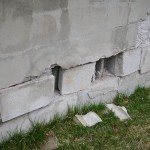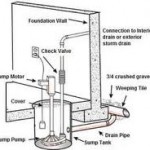What is Radon – Is It in Your Home
Radon is a gas produced by the radioactive decay of the element radium. Radioactive decay is a natural, spontaneous process in which an atom of one element decays or breaks down to form another element by losing atomic particles (protons, neutrons or electrons). When solid radium decays to form radon gas, it loses two protons and two neutrons. These two protons and two neutrons are called an alpha particle, which is a type of radiation. The elements that produce radiation are referred to as radioactive. Radon itself is radioactive because it also decays, losing an alpha particle and forming the element polonium
Elements that are naturally radioactive include uranium, thorium, carbon and potassium, as well as radon and radium. Uranium is the first element in a long chain of decay that produces radium and radon. Uranium is referred to as the “parent” element, and radium and radon are called “daughters” or “progeny.” Radium and radon also form daughter elements as they decay. The progeny of radon are called radon decay products, or RDPs.
The decay of each radioactive element occurs at a very specific rate. How fast an element decays is measured in terms of the element’s “half-life,” or the amount of time for one-half of a given amount of the element to decay. Uranium has a half-life of 4.4 billion years, so a 4.4-billion-year-old rock has only half of the uranium with which it started. The half-life of radon is only 3.8 days.
If a jar were filled with radon, only half of the radon would be left after 3.8 days. But the newly-made daughter products of radon (or RDPs) would also be in the jar, including polonium, bismuth and lead. Polonium is also radioactive. It is this element which is produced by radon in the air and in people’s lungs that can hurt lung tissue and cause lung cancer.
Radioactivity is commonly measured in picocuries (pCi).
Because the level of radioactivity is directly related to the number and type of radioactive atoms present, radon and all other radioactive atoms are measured in picocuries. For instance, a house having 4 picocuries of radon per liter of air (4 pCi/L) has about eight or nine atoms of radon decaying every minute in every liter of air inside the house. A 1,000-square-foot house with 4 pCi/L of radon has nearly 2 million radon atoms decaying inside it every minute.
Radon levels in outdoor air, indoor air, soil air and groundwater can be very different. Outdoor air ranges from less than 0.1 pCi/L to about 30 pCi/L, but it probably averages about 0.2 pCi/L. Radon in indoor air ranges from less than 1 pCi/L to about 3,000 pCi/L, but it probably averages between 1 and 2 pCi/L. Radon in soil air (the air that occupies the pores in soil) ranges from 20 or 30 pCi/L to more than 100,000 pCi/L; most soils in the United States contain between 200 and 2,000 pCi of radon per liter of soil air. The amount of radon dissolved in groundwater ranges from about 100 to nearly 3 million pCi/L. Natural Radiation Exposure
Since the beginning of time, all living creatures have been exposed to radiation. We live in a radioactive world. There are many natural sources of radiation which have been present since the Earth was formed. In the last century, we have added somewhat to this natural background radiation with artificial sources. However, the naturally occurring sources contribute about four to five times more radiation than human-made sources.
The three major sources of naturally occurring radiation are:
• cosmic radiation;
• sources in the earth’s crust, also referred to as terrestrial radiation; and
• sources in the human body, also referred to as internal sources.
Cosmic
The Earth and all living things on it are constantly bombarded by radiation from space, similar to a steady drizzle of rain. Charged particles from the Sun and stars interact with Earth’s atmosphere and magnetic field to produce a shower of radiation, typically beta and gamma radiation. The dose from cosmic radiation varies in different parts of the world due to differences in elevation and to the effects of the Earth’s magnetic field. Cosmic radiation comes from the Sun and outer space, and consists of positively charged particles, as well as gamma radiation. At sea level, the average cosmic radiation dose is about 26 millirems (mrem) per year. At higher elevations, the amount of atmosphere shielding cosmic rays decreases and, thus, the dose increases. The average dose in the United States is approximately 28 mrem per year.
Terrestrial
Radioactive material is also found throughout nature. It is in the soil, water and vegetation. Low levels of uranium, thorium and their decay products are found everywhere. This is called terrestrial radiation. Some of these materials are ingested with food and water, while others, such as radon, are inhaled. The dose from terrestrial sources also varies in different parts of the world. Locations with higher concentrations of uranium and thorium in their soil have higher dose levels.
The major isotopes of concern for terrestrial radiation are uranium and its decay products, such as thorium, radium and radon.
There are natural sources of radiation in the ground, rocks, building materials and potable water supplies. Radon gas is a current health concern. This gas results from the decay of natural uranium in soil. Radon, which emits alpha radiation, rises from the soil under houses and can build up in homes, particularly well-insulated homes. In the United States, the average effective whole-body dose of radon is about 200 mrem per year, while the lungs receive approximately 2,000 mrem per year.
Internal
In addition to cosmic and terrestrial sources, all humans are born with naturally occurring radionuclides, such as Potassium-40, Carbon-14, Lead-210, and other isotopes. The variation in dose from one person to another is not as great as the variation in dose from cosmic and terrestrial sources. The average annual “dose” from internal radioactive material is about 40 mrem.
Ionizing Radiation Exposure to the Public
This chart shows that of the total dose of about 360 millirems per year, natural sources of radiation account for about 82% of all public exposure, while man-made sources account for the remaining 18%.
Government of Canada Radon Guideline
Did you know?
The Canadian guideline for radon is 200 becquerels per cubic meter, If the radon level is found to be high, it can be fixed.
Health Canada collaborated with the Federal Provincial Territorial Radiation Protection Committee (FPTRPC) to review the health risk from exposure to radon. The risk assessment is based on new scientific information and was the subject of broad public consultation. Using the risk assessment and feedback obtained from the public consultation, the Government of Canada is updating its guideline for exposure to radon in indoor air. This updated guideline provides advice that is more broadly applicable and more protective than the previous FPTRPC guideline.
The Minister recommends that
• Remedial measures should be undertaken in a dwelling whenever the average annual radon concentration exceeds 200 Bq/m³ in the normal occupancy area.
• The higher the radon concentration, the sooner remedial measures should be undertaken.
• When remedial action is taken, the radon level should be reduced to a value as low as practicable.
• The construction of new dwellings should employ techniques that will minimize radon entry and will facilitate post-construction radon removal, should this subsequently prove necessary.
• In addition to residential homes, the term “dwelling” in this guideline also applies to public buildings with a high occupancy rate by members of the public such as schools, hospitals, long-term care residences, and correctional facilities. The following settings are excluded from this guideline:
o Uranium mines, which are regulated by the Canadian Nuclear Safety Commission;
o Other mines (e.g., fluorspar mines), which are regulated by provincial mining authorities; and
o Other workplaces which would be addressed by existing guidelines for naturally occurring radioactive materials (NORM). Details are given in theCanadian Guidelines for Management of Naturally Occurring Radioactive Materials (NORM) and a copy may be viewed or downloaded.
• The “normal occupancy area” refers to any part of the dwelling where a person is likely to spend several hours (greater than four) per day. This would include a finished basement with a family room, guest room, office or work shop. It would also include a basement apartment. It would exclude an unfinished basement, a crawl space, or any area that is normally closed off and accessed infrequently, e.g., a storage area, cold room, furnace room, or laundry room.
• The aim is to remediate and reduce the radon concentration to less than 200 Bq/m³. If the radon concentration is found to be greater than 600 Bq/m³, the remedial actions are recommended to be completed in less than a year; between 200 Bq/m³ and 600 Bq/m³, the remedial actions should be completed in less than two years.
• “As low as practicable” refers to what can be achieved with conventional radon reduction methods in a cost-effective manner. This is consistent with the ALARA (As Low As Reasonably Achievable) principle, whereby reasonable efforts are made to maintain radiation exposures as low as possible, with social and economic factors taken into consideration. In most situations, a final level less than 200 Bq/m³ will be readily achievable. In a small number of cases, it may happen that the application of all reasonable remediation techniques will still leave a residual radon level greater than 200 Bq/m³. It is not the intention of this guideline to recommend excessive or unreasonable remediation costs in order to achieve a marginal increase in benefit. Such situations should be evaluated on a case-by-case basis.
• This Government of Canada guideline is based on the guidance approved by the FPTRPC. The guideline is based upon current scientific understanding. It will be reviewed and updated as appropriate. Further information on the Federal Provincial Territorial Radiation Protection Committee is available.
Brought to you by the Barrie Home Inspector – Your Radon Specialist for Barrie, Alliston, Orillia, Midland, Penetang, Bradford, Newmarket and Aurora



Recent Comments